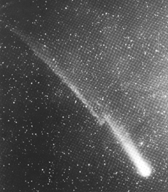|
Sunlight pressure cannot explain such behavior, but in 1943 Cuno Hoffmeister in Germany, and later Ludwig Biermann, proposed that apart from sunlight, the Sun also emitted a steady stream of particles, a "solar corpuscular radiation" which pushed the ions. Variations in the speed of the particles would explain the accelerations, and the tail did not point straight away from the Sun because the flow velocity of the particles was not too many times larger than the velocity of the comet itself.
Parker's Theory
No one gave a good reason why this "particle radiation" should exist, until Eugene Parker of the University of Chicago in 1958 tried to derive the equilibrium structure of the corona. One expects the corona at great distances to dwindle away to zero pressure and density, but Parker found that the conduction of heat interfered with such an equilibrium and instead another solution suggested itself, in which the topmost layers of the corona flowed away from the Sun at a velocity like that of Biermann's "corpuscular radiation." The flow was named "solar wind" and its existence was later confirmed by instruments aboard spacecraft.
The solar wind shapes the Earth's magnetosphere and supplies energy to its many processes. Its density at the Earth's orbit is around 6 ions per cubic centimeter--far, far less than that of the "best vacuum" obtainable in labs on Earth. The distribution of ions in the solar wind generally resembles the distribution of elements on the Sun-- mostly protons, with 5% helium and smaller fractions of oxygen and other elements. (There are electrons too, of course, counteracting the positive charge of the ions and keeping the plasma electrically neutral.) All this flows away from the Sun with a mean speed of about 400 km/sec, and as shown by the Voyager 2 space probe, this flow extends past the outermost planets, more than 30 times more distant from the Sun than Earth, and it probably continues much further than that.
The Interplanetary Magnetic Field
The regions where the solar wind starts are immersed in the Sun's magnetic field (though perhaps in regions where that field is relatively weak). However, plasma outflows from regions of magnetic fields can spread those fields to wherever they arrive. This happens by "field line preservation," a property derived from the equations of an ideal plasma. By those equations, in an ideal plasma ions and electrons which start out sharing the same magnetic field line continue to do so later on, as if the line were a (deformable) wire and the particles beads threaded by it.
If the energy of the magnetic field is dominant, its field lines keep their shapes and particle motion must conform to them; that is what happens in the radiation belts. On the other hand, if the energy of the particles is dominant--that is, if the field is weak and the particles dense--the motion of the particles is only slightly affected, whereas the field lines are bent and dragged to follow that motion. That is the case with the solar wind.
Imagine a field line extending from the bulk of the Sun to the upper corona. The particles at its "roots" stay with the Sun, but those in the high corona flow out with the solar wind, to the Earth's orbit and far beyond. All that time (under ideal conditions--a fair approximation) the same field line continues to link both groups. Thus some solar field lines will extend to the Earth and further out, producing the interplanetary magnetic field (IMF). It is the IMF that allows the solar wind to "pick up" the ions in a comet's ion tail, as it also did to an "artificial comet" produced in a 1985 experiment (see positive ions, "clouds of barium ions"). As will be seen, the IMF plays a major role in linking the magnetosphere to the solar wind.
|

 Official GSFC Home Page
Official GSFC Home Page  NASA WWW Home Page
NASA WWW Home Page